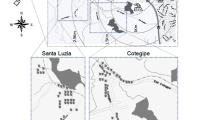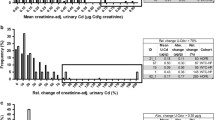Abstract
Objectives
This study was initiated to investigate the extents of biological variations in cadmium and three common tubular dysfunction marker levels in blood and urine through repeated sampling.
Methods
A 12-month survey and a 10-week survey were conducted in an area with no known cadmium pollution. In the 12-month survey, five adult women offered urine samples once every month and blood samples once in every season, respectively. In the 10-week survey, 17 adult women gave urine samples once every week. Blood and urine samples were analyzed for cadmium (Cd-B and Cd-U) by graphite-furnace atomic absorption spectrometry, and urine samples were analyzed also for α1-microglobulin (α1-MG-U), β2-microglobulin (β2-MG-U) and N-acetyl-β-d-glucosaminidase (NAG-U) by conventional methods, all under strict quality control. The results were subjected to statistical analysis to examine the extents of biological variations through-out the study periods.
Results
Variations in geometric means (GMs) for Cd-B, Cd-U, α1-MG-U, β2-MG-U, and NAG-U were all small; the ratio of the largest GM over the lowest GM was 1.1 for Cd-B, 2 for Cd-U and 2 to 3 for α1-MG-U, β2-MG-U, and NAG-U in the 12-month survey, and 1.7 at largest for all parameters in the 10-week survey. The within-subject variations during the 12-month or 10-week periods were however large, i.e., more than 4–5-fold difference between the smallest and the largest values obtained for the same subject. Effects of the correction for urine density to reduce the variations were limited. In contrast, within-subject variation in Cd-B was small with a ratio of 1.3.
Conclusions
Variations in GM values for Cd-U, α1-MG-U, β2-MG-U, and NAG-U at different time of sampling are small so that single measurement would be acceptable as far as the evaluation on a group basis is the study objective. Within-subject variations are wide however, the ratio of the largest value over the smallest value being 4–5 or more, irrespective of correction for urine density. Therefore, care should be practiced when evaluation on an individual basis is intended. Very low within-subject variation in Cd-B may suggest the advantage of Cd-B over Cd-U for individual evaluation among general populations if blood sampling is accepted.



Similar content being viewed by others
References
Arisawa K, Nakano A, Honda S, Saito H (1997) Reproducibillity of urinary β2-microglobulin and cadmium excretion among residents in a cadmium-polluted area during a 3-year period. Toxcol Lett 91:147–152
Bragigand V, Berthet B, Amiard JC, Rainbow PS (2004) Estimates of trace metal bioavailability to humans ingesting contaminated oysters. Food Chem Toxicol 42:1893–1902
Buchwald H (1964) The expression of urine analysis results—Observations on the use of specific gravity correction. Ann Occup Hyg 7:125–136
Černá M, Spěváčková V, Čejchanová M, Beneš B, Rössner P, Bavorová H, Očadlíková D, Šmíd J, Kubínová R (1997) Population-based biomonitoring in the Chech Republic—the system and selected results. Sci Total Environ 204:263–270
dell’Omo M, Muzi G, Piccinini R, Gambelunghe A, Morucci P, Tiziana F, Ambrogi M, Abritti G (1999) Blood cadmium concentrations in the general population of Umbria, Central Italy. Sci Total Environ 226:57–64
Ezaki T, Tsukahara T, Moriguchi J, Furuki K, Fukui Y, Ukai H, Okamoto S, Sakurai H, Honda S, Ikeda M (2003) Analysis for threshold levels of cadmium in urine that induce tubular dysfunction among women in non-polluted areas in Japan. Int Arch Occup Environ Health 76:197–204
Fraser CG, Harris EK (1989) Generation and application of data on biological variation in clinical chemistry. Crit Rev Clin Lab Sci 27:409–437
Hoffmann K, Becker K, Friedrich C, Helm D, Krause C, Seifert B (2000) The German Environmental Survey 1990/1992 (GerES II); cadmium in blood, urine and hair of adults and children. J Expo Anal Environ Epidemiol 10:126–135
Horiguchi H, Oguma E, Sasaki S, Miyamoto K, Ikeda Y, Machida M, Kayama F (2004) Dietary exposure to cadmium at close to the current provisional tolerable weekly intake does not affect renal function among female Japanese farmers. Environ Res 95:20–31
Ikeda M, Zhang Z-W, Shimbo S, Watanabe T, Nakatsuka H, Moon C-S, Matsuda-Inoguchi N, Higashikawa K (2000) Urban population exposure to lead and cadmium in east and south-east Asia. Sci Total Environ 249:373–384
Ikeda M, Ezaki T, Tsukahara T, Moriguchi J, Furuki K, Fukui Y, Ukai H, Okamoto S, Sakurai H (2003) Threshold levels of urinary cadmium in relation to increases in urinary β2-microglobulin among general Japanese populations. Toxicol Lett 137:135–141
Ikeda M, Ezaki T, Tsukahara T, Moriguchi J, Furuki K, Fukui Y, Ukai H, Okamoto S, Sakurai H (2005) Reproducibility of urinary cadmium, α1-microglobulin, and β2-microglobulin levels in health screening of the general population. Arch Environ Contam Toxicol 48:135–140
International Programme on Chemical Safety (1992a) Environmental Health Criteria. 134 Cadmium. World Health Organization, Geneva
International Programme on Chemical Safety (1992b) Environmental Health Criteria. 135 Cadmium – environmental aspect. World Health Organization, Geneva
Iwata K, Saito H, Moriyama M, Nakano A (1993) Renal tubular function after reduction of environmental cadmium exposure: a ten-year follow-up. Arch Environ Health 48:157–163
Jackson S (1966) Creatinine in urine as an index of urinary excretion rate. Health Phys 12:843–850
Kawada T (1995) Indicators of renal effects of exposure to cadmium: N-acetyl-β-d-glucosaminidase and others. J Occup Health 37:69–73
Kido T, Honda R, Tsuritani I, Yamaya H, Ishizaki M, Yamada Y, Nogawa K (1988) Progress of renal dysfunction in inhabitants environmentally exposed to cadmium. Arch Environ Health 43:213–217
Kruzynski GM (2004) Cadmium in oysters and scallops: the BC experience. Toxicol Lett 148:159–169
Levine L, Fahy JP (1945) Evaluation of urinary lead concentrations: 1. The significance of the specific gravity. J Ind Hyg Toxicol 27:217–223
Mason HJ, Williams NR, Morgan MG, Stevenson AJ, Armitage S (1998) Influence of biological and analytical variation on urine measurements for monitoring exposure to cadmium. Occup Environ Med 55:132–137
Moriguchi J, Ezaki T, Tsukahara T, Furuki K, Fukui Y, Okamoto S, Ukai H, Sakurai H, Shimbo S, Ikeda M (2003) Comparative evaluation of four urinary tubular dysfunction markers, with special references to the effects of aging and correction for creatinine concentration. Toxicol Lett 143:279–290
Moriguchi J, Ezaki T, Tsukahara T, Furuki K, Fukui Y, Okamoto S, Ukai H, Sakurai H, Ikeda M (2004) α1-Microglobulin as a promising marker of cadmium-induced tubular dysfunction, possibly better than β2-microglobulin. Toxicol Lett 148:11–20
Moriguchi J, Ezaki T, Tsukahara T, Furuki K, Fukui Y, Okamoto S, Ukai H, Sakurai H, Ikeda M (2005) α1-Microglobulin levels and correlation with cadmium and other metals in urine of non-smoking women among general populations in Japan. Toxicol Environ Chem 87:119–133
Noonan CW, Sarasua SM, Campagna D, Kathman SJ, Lybarger JA, Mueller PW (2002) Effects of exposure to low levels of environmental cadmium on renal biomarkers. Environ Health Perspect 110:151–155
Ormos G, Cseh J, Groszmann M, Timar M (1985) Urinary β2-microglobulin and retinol binding protein; individual fluctuations in cadmium-exposed workers. Toxicol Lett 24:59–64
Paschal DC, Burt V, Caudill SP, Gunter EW, Pirkle JL, Sampson EJ, Miller DT, Jackson RJ (2000) Exposure of the U.S. population aged 6 years and older to cadmium; 1988–1994. Arch Environ Contam Toxicol 38:377–383
Rainsford SG, Lloyd Davies TA (1965) Urinary excretion of phenol by men exposed to benzene; a screening test. Br J Ind Med 22:21–26
Roels HA, Lauwerys RR, Buchet JP, Bernard AM, Vos A, Oversteyns M (1989) Health significance of cadmium induced renal dysfunction; a five-year follow-up. Br J Ind Med 46:755–764
Sartor FA, Rondia DJ, Claeys FD, Staessen JA, Lauwerys RR, Bernard AM, Buchet AM, Roels HA, Bruaux PJ, Ducofere GM, Lijnen PJ, Thijs LB, Amery AK (1992) Impact of environmental cadmium pollution on cadmium exposure and body burden. Arch Environ Health 47:237–353
Schaller KH (1996) 3.1 Cadmium. In: Biological monitoring of chemical exposure in the workplace, vol 1. World Health Organization, Geneva, pp 52–73
Shimbo S, Zhang Z-W, Moon C-S, Watanabe T, Nakatsuka H, Matsuda-Inoguchi N, Higashikawa K, Ikeda M (2000) Correlation between urine and blood concentrations, and dietary intake of cadmium and lead among women in the general population of Japan. Int Arch Occup Environ Health 73:163–170
Tohyama C, Kobayashi E, Saito H, Sugihara N, Nakano A, Mitane Y (1986) Urinary α1-microglobulin as an indicator protein of renal tubular dysfunction caused by environmental cadmium exposure. J Appl Toxicol 6:171–178
Tsukahara T, Ezaki T, Moriguchi J, Furuki K, Shimbo S, Matsuda-Inoguchi N, Ikeda M (2003) Rice as the most influential source of cadmium intake among general Japanese population. Sci Total Environ 305:41–51
Watanabe T, Zhang Z-W, Moon C-S, Shimbo S, Nakatsuka H, Matsuda-Inoguchi N, Higashikawa K, Ikeda M (2000) Cadmium exposure of women in general populations in Japan during 1991–1997 compared with 1977–1981. Int Arch Occup Environ Health 73:26–34
Yamagami T, Ezaki T, Moriguchi J, Fukui Y, Okamoto S, Ukai H, Sakurai H, Aoshima K, Ikeda M (2006) Low-level cadmium exposure in Toyama City and its surroundings in Toyama prefecture, Japan, with references to possible contribution of shellfish intake to increase urinary cadmium levels. Sci Total Environ 362:56–67
Zhang Z-W, Shimbo S, Ochi N, Eguchi M, Watanabe T, Moon C-S, Ikeda M (1997) Determination of lead and cadmium in food and blood by inductively coupled plasma mass spectrometry: a comparison with graphite furnace atomic absorption spectrometry. Sci Total Environ 205:179–187
Acknowledgments
The authors are grateful to the administration and staff in Hokuriku Health Service Association, Toyama 930-0177, Japan, and those in Kyoto Industrial Health Association, Kyoto, 604-8472, Japan.
Author information
Authors and Affiliations
Corresponding author
Rights and permissions
About this article
Cite this article
Yamagami, T., Suna, T., Fukui, Y. et al. Biological variations in cadmium, α1-microglobulin, β2-microglobulin and N-acetyl-β-d-glucosaminidase in adult women in a non-polluted area. Int Arch Occup Environ Health 81, 263–271 (2008). https://doi.org/10.1007/s00420-007-0206-z
Received:
Accepted:
Published:
Issue Date:
DOI: https://doi.org/10.1007/s00420-007-0206-z




